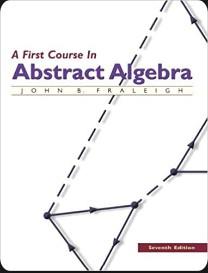We showed in Example 15.6 that A 4 has no subgroup of order 6. The preceding exercise
Question:
We showed in Example 15.6 that A4 has no subgroup of order 6. The preceding exercise shows that such a subgroup of A4 would have to be isomorphic to either Z6 or S3. Show again that this is impossible by considering orders of elements.
Data from in Example 15.6
The theorem of Lagrange states if H is a subgroup of a finite group G, then the order of H divides the order of G. We show that it is false that if d divides the order of G, then there must exist a subgroup H of G having order d. Namely, we show that A4 , which has order 12, contains no subgroup of order 6.
Suppose that H were a subgroup of A4 having order 6. As observed before in Example 15.4, it would follow that H would be a normal subgroup of A4 . Then A4/H would have only two elements, H and σ H for some σ ∈ A4 not in H. Since in a group of order 2, the square of each element is the identity, we would have H H = H and (σH)(σH) = H. Now computation in a factor group can be achieved by computing with representatives in the original group. Thus, computing in A4 , we find that for each α ∈ H we must have α2 ∈ H and for each β2 ∈ σ H we must have β2 ∈ H. That is, the square of every element in A4 must be in H. But in A4 , we have (1, 2, 3) = (1, 3. 2)2 and (1, 3, 2) = (1, 2, 3)2 so (1, 2, 3) and (1, 3, 2) are in H. A similar computation shows that (1, 2, 4), (1, 4, 2), (1, 3, 4), (1, 4, 3), (2, 3, 4), and (2, 4, 3) are all in H. This shows that there must be at least 8 elements in H, contradicting the fact that H was supposed to have order 6.
Step by Step Answer:






